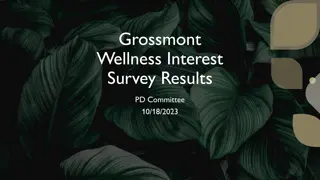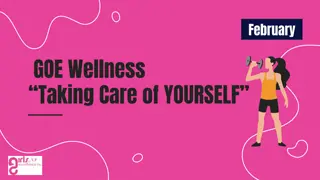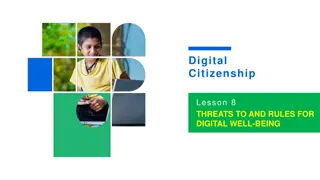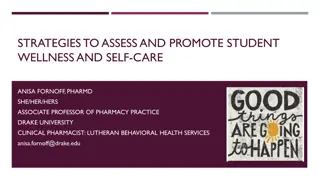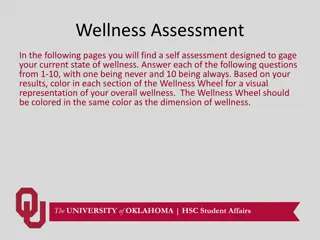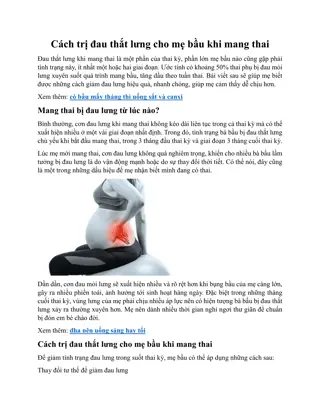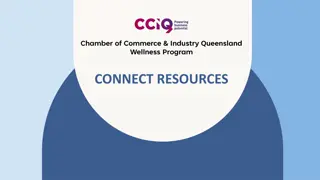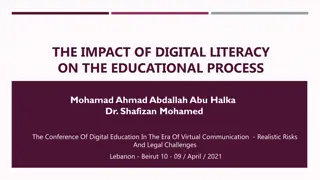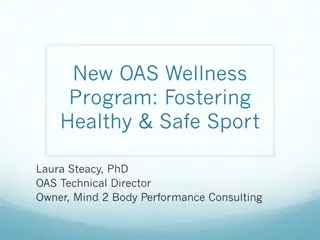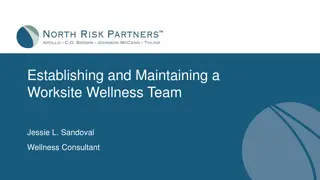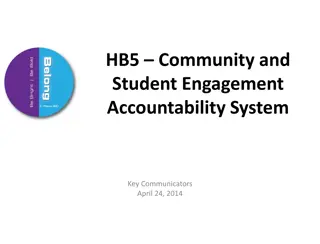Understanding Factors that Impact Digital Wellness
Well-being, encompassing physical, emotional, and social aspects, is crucial for individuals and societies. Factors like social connections, emotional regulation, physical health, nutrition, and technology usage play a significant role in digital wellness. Maintaining a healthy balance in these areas is essential to promote overall well-being in the digital age.
Download Presentation

Please find below an Image/Link to download the presentation.
The content on the website is provided AS IS for your information and personal use only. It may not be sold, licensed, or shared on other websites without obtaining consent from the author. Download presentation by click this link. If you encounter any issues during the download, it is possible that the publisher has removed the file from their server.
E N D
Presentation Transcript
FACTORS THAT IMPACT DIGITAL WELLNESS
CONTENTS Concept of well- being Concept of Digital Well being Why should we be concerned? Factors that impact digital wellness Risk and protective factors How much is too much? Maintaining a healthy social media relationship
Well-being Well-being is a positive state experienced by individuals and societies. Determined by social, economic and environmental conditions. Well-being encompasses quality of life and the ability of people and societies to contribute to the world with a sense of meaning and purpose. Characterized by good- health, happiness and satisfaction
Social factors The relationships we maintain with others hold a significant key to our overall health. Interacting with people, fostering an attitude of care and concern for each other, enhances our sense of purpose and connectedness to society and to ourselves.
Emotional factors Recognition for the way we feel Regulating our emotions can offer insight into situations and experiences we encounter.
Physical factorsPhysical health can include exercise but may not need to be of the extreme level. Your level of fitness is suited to you. Do you need to just be active by walking for 30 minutes a day or do you need to go to the gym and lifting weights?
Nutritional factors eating fresh food often supports a nutritionally balanced diet. This allows our body to recharge, reinvigorate and function effectively. Environmental factors impacts can be felts through our surroundings. Enjoying sunlight, fresh air, and ergonomic spaces can all support our environmental wellbeing.
Technological the amount of time spent on technological devices will depend of many factors. Which device you use can play a part in the balance of wellbeing too. When on social media platforms, a conscious awareness towards the type of articles you are reading, the time spent being absorbed in the application and the time of day can all affect our overall wellbeing.
Psychological how is your sense of self? Do you perceive yourself to be a positive person who is self-aware? Do you have an awareness towards your specific traits, different behaviors and the emotions displayed or felt in different situations?
Mental our brains play such an important role towards our perception and sense of reality. Our subconscious brain can dictate our thoughts and patterns of belief from a very young age. Are all your thoughts positive? It is not expected that we only display positive thoughts, but an awareness to our reality and how we are perceiving it can play an enormous part of our day. Are our thoughts supporting us to achieve our overall wellbeing?
Digital wellbeing Digital wellbeing is a term used to describe the impact of technologies and digital services on people's mental, physical, social and emotional health. Schools have encountered difficult and challenging times over the past few years in light of remote learning and the COVID-19 pandemic. Students have seen changes in the way they use technology to interact at school. This can include classroom participation, socialising with friends and communication with members of staff.
As well as students, staff have also had to navigate a difficult climate where technology has played a more active role in education. Now, schools have returned to regular practice, but technology continues to be used more than ever. Students in particular can have a very active online life from a young age which can shape and impact their digital wellbeing.
Why should we be concerned? A growing proportion of children and adolescents' leisure time is spent with screens including smartphones, tablets, gaming consoles, and televisions Adolescence is defined as the time between puberty and adult independence During this period adolescents actively develop their personalities. During adolescence, general levels of life satisfaction and self-esteem drop and are often at their all-time lowest. At the same time, media use increases and reaches a first peak in late adolescence
Adolescents are also more likely than younger children to have their own smartphone, which allows the use of technology in more situations. This may increase the possibility of Internet addiction, excessive gaming, or problematic social media use, which has been linked to low well-being High users of screens were significantly more likely to display poor emotion regulation (not staying calm, arguing too much, being difficult to get along with)
Also they are seen to have an inability to finish tasks, lower curiosity, and more difficulty making friends. Smartphones may also be used during face-to-face social interactions, which may negatively impact those interactions and blunt their usually positive impact on well-being This has a direct impact on their academic performance and quality of life.
Categories of risks that adolescents are exposed to when using digital media Content risks Adolescent engages with, or is exposed to, potentially harmful content, including violent or pornographic material; discriminatory, hateful, or extremist information; content that perpetuates harmful body image norms; misinformation or disinformation; or age inappropriate marketing
Contact risksAdolescent experiences or is targeted by potentially harmful adult contact resulting in harassment; unwanted surveillance; sexual abuse; or ideological persuasion, manipulation, or radicalisation Conduct risks Adolescent witnesses, participates in, or is a victim of potentially harmful peer contact, resulting in bullying, hostile communication or peer activity (eg, trolling), sexual harassment, non- consensual messaging, or harmful user communities (eg, self-harming or dangerous online challenges)
Contract risksAdolescent is party to, or exploited by, potentially harmful contracts such as identity theft, fraud, online scams, trafficking for sexual exploitation, gambling, micro-targeting of content, and marketing practices that shape behaviour or purchases Other cross cutting risks This category includes privacy violations (interpersonal, institutional, commercial), negative physical and mental health impacts of excessive digital media use
How does digital space affect well being?
Emotional Health The thing with digital is that it gives access to so much and actually to so little so we might tend to view other people s lives, whom we perceive as successful or as role models, in an idealised manner that affects the view on our own lives. Truth is real life is rarely glamourous something we must all remember when we might use online as a form of escapism.
Emotional Health At the same time, online has enabled so many people to reach out for help and for others to offer it, supporting them throughout the process. Watching entertaining content can make us laugh and raise our spirits, while reading hostile comments makes us angry and causes bad mood.
Possible examples: Negative impact: Emphasising one s differences; Comparing oneself to others. Dating apps can also be detrimental to a person s digital well-being. Studies have shown that these apps can impact body image and self-esteem. When people are constantly swiping left and right, judging people based on their looks, it can lead to feelings of insecurity and anxiety. Positive impact: Finding sources of support and help; Connecting with other people who are experiencing the same issues
Psychological well- being Do you ever panic when you can t find your phone? Or dare you constantly checking it and browsing social media to make sure you haven t missed anything? If that has become an automatism, in the long run its effects can be negative. Mostly because they give you a false sense of connection, when in fact they make you disconnect to the real world.
Psychological well- being Negative impact: Encouraging addictive behaviours; Compromising online safety; Promoting feelings of self-worth Direct relationship between screen time and insufficient sleep and physiological stress mind wandering, difficulty in sustaining attention nonadaptive/negative thinking styles, decreased life satisfaction
Psychological well- being Addictive behaviour : Nomophobia, phubbing, zero inbox syndrome, phantom vibration syndrome, binge watching, technoference Misinformation Early exposure to pornographic material Positive impact: Creative a sense of belonging: Helping people to reach their potential (through learning opportunities or making connections); Providing opportunities for creativity
Social health While digital helps connection & discovery, it can sometimes also highlight & encourage extremist views and aggressive stands towards what people perceive as different to their own views. At the same time, digital gives access to endless educational & practical resources, as well as solutions to current challenges (eg: online courses during lockdowns, remote work etc)
Social health Possible examples: Negative impact: Experiencing or engaging in cyberbullying; Being a victim of crime (eg: stalking, grooming) Positive impact: Preventing isolation; Connecting with others (family friends, communities); Enabling participation (as a citizen or community member); Supporting others; Collaborating; Sharing content with other people
Physical health Sedentarism is probably one of the most important health issues of modern life as a lot of people work in offices, the focus on exercise and time spent outdoors is radically affected (and the pandemic & lockdowns didn t help either). People might trade exercise & active leisure to activities that seem more relaxing , but which are actually encouraging standing and unhealthy behaviours.
Physical health At the same time, if used in a constructive manner, digital can help maintain a healthy lifestyle and give the right tools to enable that. Possible examples: Negative impact: Impact on muscular and skeletal health; Impact on sleep patterns, eye- strain, neck pain Positive impact: Using fitness health; Monitoring health; Assistive technologies for physical conditions (temporary or permanent)
How much is too much? You may need to make some changes to your digital device use if: 1. eyes, blurred vision, double vision, dry eyes, eye redness or headaches 2. You spend more time communicating with others digitally than face-to- face 3. You feel anxious when you do not have access to your digital devices You feel symptoms of eye strain including eye watering, tired or aching
How much is too much? 4. Feeling overwhelmed or stressed because of information overload 5. You find yourself comparing yourself to others 6. You have difficulty sleeping or have disruptions in sleeping pattern 7. You are having fewer face-to-face conversations with your friends and family 8. You're feeling disconnected from those closest to you 9. Using the internet is preventing you from getting other things done in the offline world 10. Using the internet or social media is leading to feelings of being overwhelmed
Risk factors Digital Drama Desire to fit-in Distressing content Screen time
Protective factors Digital resilience - coping strategies, recovery, and learning from online hazards. Digital resilience acts as a protective factor for adolescent wellbeing, shielding them from potential online risks. Adolescent digital resilience can be boosted via socio-ecological factors (e.g., individuals, family, and school).
Involvement in extra-curricular activities Parental involvement and a better quality of family relationships seem to be associated with less problematic use of the internet
Maintaining a healthy relationship with social media Knowing how you use social media and its impact on your digital well- being is important. Be mindful of the amount of time you're spending on social media. Try to limit yourself to a certain number of minutes or hours per day. Be aware of the content you're consuming on social media. Make sure it's positive and uplifting and doesn't make you anxious or stressed. Digital Literacy is the ability of individuals and communities to understand and use digital technologies for meaningful actions within life situations.
Engage with social media in a way that feels good for you. If you're feeling overwhelmed, take a break from it digital detox Make sure to connect with people offline as well as online. Social media should be just one part of your life, not the only part. Talk to someone if you feel like social media negatively impacts your mental health. A professional can help you figure out how to best use social media healthily.
With this increased reliance on technology comes an increased need for good digital citizenship. Good digital citizenship means being aware of how your actions online can affect your reputation and the reputation of others. It also means being cautious about what you share online and with whom you share it. In the age of social media, it's easy to forget that anyone and everyone can see the things you post. That's why it's so important to think before you post and consider your actions' potential consequences.
Digital Citizenship Maintaining your privacy, personal information, and personal content. It also means understanding and managing your digital footprint with professionalism. Good digital citizenship will benefit you in many ways. For one, it will help you maintain your privacy and keep your personal information safe. It will also help you manage your digital footprint to be professional and positive. Finally, good digital citizenship will help you build a strong online reputation.
To be a good digital citizen, you can: Protect your privacy by being careful about what you share online. Manage your digital footprint by regularly monitoring what is being said about you Build a strong online reputation by creating positive content and engaging in positive online activity.
What Can Schools Do? Encourage appropriate breaks away from devices Create safe spaces for individuals to talk through concerns Encourage the use of parental controls and filtering options for apps where necessary Appropriate offline activities in school Have staff maintain a good understanding of trends and popular apps Develop a school community approach towards online critical thinking Explain what harmful online content is and ways it can present itself Making the community aware of online reporting routes





